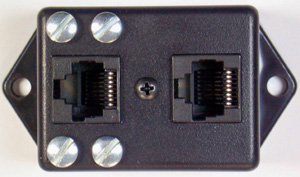IP VIDEO AND LIGHTING NEAR MISSES
By Frank McClatchie
LIGHTNING HAPPENS. You cannot control it, and when it happens near an IP Picture Transmission System, the differential current flowing in the ground and the twisted Pairs carrying the digital picture information can be enough to damage the terminating resistors in the system changing the value of those resistors from 100 Ohms to some other value. When this takes place a reflection of the digital signal will occur and if this resistance change is large enough, digital errors will be introduced into the receiving equipment caused by the lightning that can cause intermittent failure or complete inability to transmit a picture.
Of course a direct lightning strike will completely blow out the terminal equipment resulting in a charred mess but a NEAR MISS can cause resistance change that is not visible to the casual observer and still cause intermittent picture failures. Even the IP cable can be damaged by close lightning strikes. If you work in an area frequented by lightning storms, some of your IP picture problems could be caused by a close NEAR MISS. If there are no grounds attached to your IP video camera your system will be safe from all but the closest of lightning strikes.
Even if the Camera is not actually grounded a nearby lightning strike can induce a high voltage into the “local ground” and even a very small capacity from that local ground to the Camera will be sufficient to cause direct damage and/or differential currents in the twisted pair that can damage the terminating resistances. Most IP video transmission systems are very short by their nature but lightning can induce a high voltage on one side of a building relative to the system ground applying a very high local ground voltage directly into the associated equipment in the building.
Lightning Arresters are used to protect people from lightning by diverting the high voltage spikes to a local ground however at the same time that they are protecting people from electrocution they are also re-routing that lightning current directly into any equipment that happens to be grounded.
Another possible lightning damage issue is with the “POE Power Over Ethernet that is applied to the IP system to power the Cameras. With the rather high voltages encountered in lightning strikes a very small capacity between the Camera, Recorder, or IP Cable and the local ground can induce differential currents and voltages into the IP System to cause the IP Camera system to default. Normally small near miss strikes will only cause the P.O.E. power supply to reset due to over voltage if no damage has occurred in the P.O.E. electronics. In some P.O.E. power systems there is a resistor that is measured to determine what voltage to apply to the system and if that resistor is damaged by a strike, the P.O.E. system could supply the wrong voltage to the equipment. It is a good idea to make up an inline connector that connects the IP signals and gives you access to measure the P.O.E. voltage and put that in your tool box to check the voltage when in doubt.
In the past about the only way of discovering which piece of equipment is damaged by a close lightning strike, has been to replace equipment until the system works again. This is a very time consuming and expensive process.
There is a new piece of equipment manufactured in the United States by F M Systems, Inc. that will help find this type of lightning damage without having to swap out Cameras and Recorders or pull new wire to find the source of the problem. The IPM-4 portable hand-held meter can be used to discover just which piece of equipment needs to be replaced in the case of lightning strikes without having to stock multiple Cameras and Recorders so you can actually save time and money when troubleshooting a system.
The IPM-4 meter will discover exactly which piece of equipment is damaged by the close lightning strike. This unit will measure the actual equipment output loss as well as the amount of Common Mode loss and signal balance that is present in the signal and also calculate the decibel loss directly attributable to the IP camera output Common Mode signal in the IP System.
There are two different kinds of loss on IP cables, the normal Cable Loss over any particular length of Network Cable and an additional loss attributable to the proportion of Balanced Differential signal that has been converted to an unbalance COMMON MODE signal.
The portion of the digital signal that has been converted to Common Mode signal will be radiated out from the IP Cable just as though the cable was an antenna, and will not be available to be received at the end of the IP system. This additional loss directly caused by conversion to Common Mode is called the EXCESS LOSS and it is over and above the normal Network Cable Loss.
The IPM-4 measures the Normal Loss of your Network Cable, the degree of signal conversion to COMMON MODE and the EXCESS LOSS introduced by that conversion process. The IPM-4 will make these measurements with the Camera and Recorder in place by using that equipment as the signal source.
CLICK HERE or Call 1-800-235-6960 to receive more information about this new product or
E-mail us at:fmsystemsinc@sbcglobal.net .




